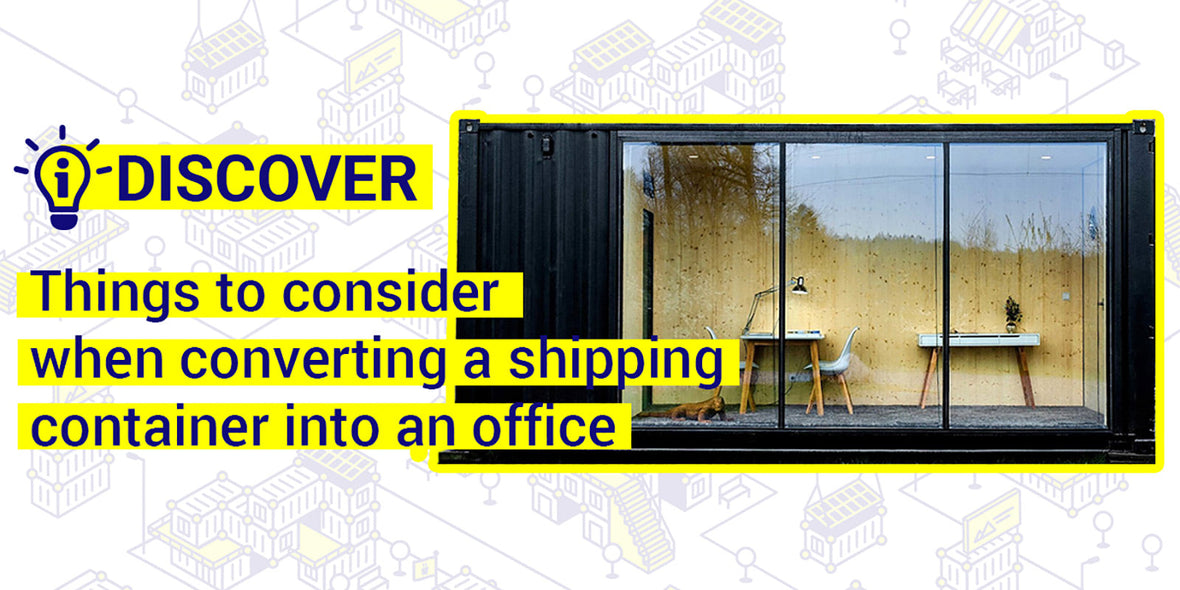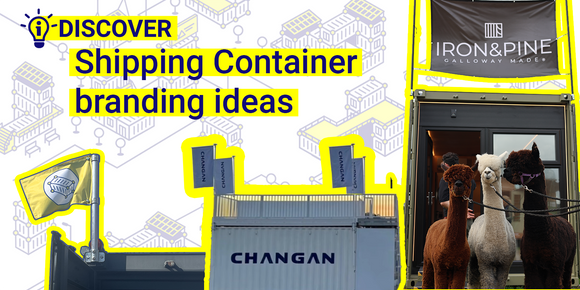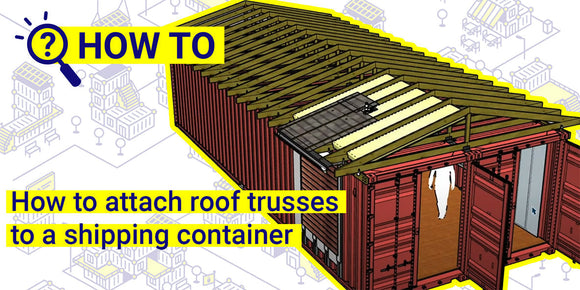
Shipping Container Office Conversion [How-to-Guide]
From a single container home office in a backyard, to big container office complexes where several of them are stacked, the conversion of shipping containers into office spaces has become more and more popular. What people love about these transformed workspaces is that they can be mobile, versatile and cost-effective.
The question is though… How do you convert a shipping container into an office? How do you modify a container so that it turns into a functional AND comfortable work space? And what should you consider before getting started with this increasingly popular container conversion project?
In 2014 we transformed an old shipping container into an office, and so we had all these same questions ourselves; Between what we learned then then and the following years of experience, this is what we found out:

What is a converted container office and why do people use them?
Working from home has become the new normal for many in the past few years but unless you have a designated work area like an office or a spare room, it is easy for your work life to overspill into your free time and vice versa.
A shipping container office can be a cost-effective and flexible home office solution or a good option for businesses wanting to build affordable workspaces. By adding ceilings and floors, partitions and some smart office furniture, a container office can provide a viable solution for many companies.
DIY container offices have several benefits:
- QUICK AND EASY:
Converted office containers can be made quickly, cheaply and without planning permission, making them the perfect choice if you are renting land and don't want to incur building or renovation costs on something you don't own.
- TRANSPORTABLE
Their mobility allows you to take your office with you if you decide to relocate in the future.
- SCALABLE
Their small size and modular nature means that you can start small and add more mini offices as your company grows.
- INVESTMENT
The money invested in converting a shipping container is never wasted; your finished office is a tangible asset which can be valued and added to your company’s balance sheet.
- EYE-CATCHING
Container offices stand out from the crowd and can help your business do the same. It's not a stretch to believe Container city’s claim that it is the most photographed container building in the world.
- SUSTAINABLE
Converted containers can be considered to be a more sustainable option that gives a second life to an old container.
How to convert a shipping container into an office?
A single container can be modified into one office, like ours, or several can be stacked to create a bigger office complex such as the two infamous examples in east London built by Container City.
If you want to transform a shipping container into your dream office space, you're in the right place. We will walk through the process together.
Understanding the Conversion Process
Understanding the entire conversion process before you get started ensures that you will have a smooth and cost-efficient conversion. Consider also which steps of the conversion you want to do by yourself, DIY style, and which you ought to get professional help with.
Your skills with different tools as well as official building regulations will decide how much to DIY and how much to get contractors to do. Map out the process and get quotes on things like transporting the container or having electricians finish any electrical wiring etc. Can you cut the metal to insert windows yourself? Will you do the insulation, etc? Get any possible quotes upfront.
Container offices can be a cost-saving project, but good planning is needed to achieve this so as not to end up with unexpected costs.

Selecting the right container for your office
To select a container, consider factors such as size, condition, and previous use:
- GENUINE ISO
- SIZE
- PRICE
One-trip containers tend to be in extremely good condition, so if you are looking to keep the conversion work to a minimum it’s worth spending a bit extra on one of these, particularly if you want your container to look neat and possible if your customers are able to see it.
If low cost is a major priority then a more well used container will be your best option. You may be lucky in finding a discount container with a tear down the side which you were going to cut out for a window anyway.
- CONDITION
Check thoroughly;
Ensure the doors open and close easily if you plan to keep them in use.
Check for damage and severe rust under the container if possible.
Check for large dents or bends in the horizontal and vertical edges of the containers.
Dents and rust on the side panels might look messy but can be painted over - they are not hugely important, structurally, and you may end up cutting parts of these away for doors and windows anyway.
Do I need planning permission for a converted office container?
Shipping container offices don't necessarily require foundations, which means they are generally classed as temporary buildings, which again means that you wouldn't normally need to get planning permission.
However, there are some circumstances where it might be required such as if you live in a conservation area, or are (most likely) planning on having plumbing and electrics installed.
Definitely check with your local planning authority before you start the project to be certain. You can either find out and get permissions by yourself, or for example have an architect who might design your office also take care of the necessary permits.
Good to know: Check our guide on how to clad your container. Adding cladding to a container can sometimes make it easier to get planning permissions because when they are clad, they blend in better with rural or urban surroundings.
Structural modifications (for doors, windows or other entry points)
Think carefully about how many windows and doors you want to install. More light coming into your office through windows will make your office a nicer environment to work in, less claustrophobic, and make it easier to ventilate.
More than one entry door, especially in a 40ft container, will reduce the amount of people filing down a narrow corridor past people working at their desks.
Each one of these new openings will likely require structural modifications. This involves cutting and reinforcing openings for doors, windows, and other entry points with internal steel framing, when cut out of the corrugated sides or roof of the container.

- Installing a window will cost about the same regardless of its size; consider installing fewer, larger windows instead of many small ones
- A sliding patio door lets in light AND doesn’t take up space when it opens, install one of these inside your double doors for maximum efficiency.
- Wall space is valuable in an office for screens, storage so don't use it all for windows. How about a massive skylight instead?
- Even a well insulated container office will get hot in summer, make sure you have windows which open.
- Have you got enough other entry points for power, internet, air conditioning etc? Consider bringing these up through the floor.
But whatever YOU wish to modify, just plan it upfront and make sure the container’s structural integrity stays intact. That means adding frames to give extra support. If in doubt, get some expert advice from architects or other conversion specialists. You can have them design your container office, and still build it yourself, or have them take care of certain parts or the whole process.
Insulation, Soundproofing, and Climate Control
Insulation and soundproofing can be done on either the inside or outside of the container:
Insulation on the outside saves space and is a good solution if you also plan to clad the container, while closed cell spray foam insulation is, for example, one efficient way to insulate containers internally.
Your container floor is likely made from 28mm plywood. Although this is a great insulator compared to the corrugated steel walls and ceiling, do not forget to further insulate the floor. Something like reflective foil insulation can quickly cover it before your final floor finish is applied and will make a big difference to the overall temperature control in the office.

Climate control systems, such as HVAC units, can further enhance the office's environment, ensuring year-round comfort for anyone working inside, though perhaps at the cost of trying to remain environmentally friendly.
Keeping your office container safe and secure
With all of your sensitive office paperwork, expensive computer equipment, and favourite teatime biscuits stashed inside, you’ll want to make sure your shipping container is secure. Adding additional locks to the outside is an absolute must, and if your container is outside, installing CCTV and night time floodlighting to act as a deterrent to would-be intruders comes high up our list of suggestions.
Ensure openable windows can be securely locked, and our tip about using a sliding patio door means that you lock that, and then close the double steel container doors and lock those for additional peace of mind.
Good to know: You can attach any outdoor lighting, any container signage, or even securely fix a security camera to your container by using Domino Clamps. You won’t need to screw into/damage your container.
Electrical, Plumbing, Lighting, Internet
Planning electrical and plumbing layouts is essential to accommodate lighting, outlets, and other fixtures. By the time you have a small heater, your lighting and computers, a toaster and a kettle in your office, you could easily end up drawing over 6000w if everything was briefly turned on simultaneously.
Make sure you have a proper 32a power supply correctly installed in a ring main around your container. Avoid using extension cables and take the time to install plenty of plug sockets neatly where you’ll be needing them in the interior walls of your container.
How urgently does your office need plumbing? It is a lot of work to get clean water to the office and grey water safely to an outflow. If you will only be making tea and coffee and rinsing the cups, is there another location nearby the office with existing plumbing that would better be used for this purpose?
Plan ahead to ensure your office has a reliable internet connection. If you're in a remote area, you can easily install a Starlink dish on top of your container office.

Interior and Exterior Finishing
Finishing touches both inside and outside the container contribute to the durability of the container and to its aesthetics. Exterior cladding can protect the container from the elements, providing insulation and give you the chance to make your converted container look exactly the way you want.
Interior finishing can include flooring, paint, and fixtures, and transforms the inside of the container office into a comfortable and inviting workspace.
Good to know: Shipping containers generally have a marine ply floor that has been treated with pesticides to prevent damage to goods by insects and other animals. These chemicals can potentially be dangerous to humans, so you may want to seal yours using an epoxy resin before laying a floor covering on top.
Sustainability and Eco-Friendliness
Repurposing used shipping containers for office spaces aligns with sustainability goals potentially reducing waste and carbon footprint.
To make it even more sustainable you could install energy efficient solar panels (read our tip below). LEED certification or other sustainability initiatives could further enhance the eco-friendliness of your office conversion. (LEED - Leadership in Energy and Environmental Design is the most widely used green building rating system worldwide.)
Good to know: You can find out here how to attach solar panels on top of your office container roof. Or even attach a solar light to your container. Container conversion creativity knows no bounds!
How much does it cost to convert a shipping container into an office?
The costs of converting a shipping container into an office vary depending on size, features, and labour costs. Container prices range from £1000 to £4000 ($1250 to $5000), with material costs to be added on top. Conversion expenses for a 20ft container office including the container price can start at around £10,000 ($12,500) for basic setups, increasing for larger or more complex builds.
Evaluate your own DIY-office-conversion skills, your familiarity with materials and tools, or those of your helpers. Identify which parts of the conversion you need to have done by contractors - and get all those quotes in before you start!
Back in 2014 we converted a shipping container into our office, and tried to do so as cheaply and sustainably as possible. Including the shipping container itself this ended up costing about £5000 in the UK (approx. $6,300 USD). These days, the full cost of a conversion could end up being as much as four times that.
Container office conversions can offer cost-effectiveness compared to traditional construction methods. Estimating each step and the project's overall cost, plus identifying some strategies to save costs along the way can help you stay within your desired budget.
Get Inspiration: Office Conversion Case Studies
Several years ago, before Domino Clamps even existed, our founder Justin converted a shipping container into an office in London, which is still in use today. See how he built the shipping container office step-by step here…
Real-world examples can show you the potential of office conversions. Although, depending on how high you aim and how advanced you want this conversion to be, a lot of what you see online can be expensive projects to showcase or might not even be real containers but AI-generated pictures. But do check out what others have done and get inspired.

Conclusion - Happy office converting!
We wish you all the best in transforming your container into your dream office.
Consider all the key steps that we mentioned in each paragraph, such as necessary modifications, permits, insulation, and more. This helps to make sure you have no (or at least as few) surprises as possible, as you transform your container.
Especially check what you will do DIY-style or what you will hire someone to do for you, and get those quotes in before you start.
Let us know if you think we covered all your queries. If you still have any questions, simply drop them in the comment section below this article and we will answer you as soon as possible!
If you would like to read more you might also like our article on used containers. Deciding which container to get can be tricky so we have put together this guide on one-trip or more used containers to help.
For more ingenious container solutions, useful information and offers delivered direct to your inbox, sign up to our information email 📨 or subscribe to our YouTube channel 📺
![Shipping Container Office Conversion [How-to-Guide] | Domino Clamps](http://dominoclamps.com/cdn/shop/files/Domino_Clamps_Logo_with-R-01.png?v=1677161489&width=200)




